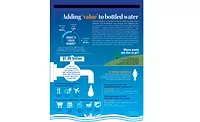Value-added caps boost cap industry growth
Consumers seek easy-open closure solutions
In the face of SKU proliferation and the growth of single-serve bottles, Cleveland-based The Freedonia Group Inc. projects that U.S. demand for beverage caps and closures will increase 4.1 percent in value and 2.1 percent in volume annually to $3.3 billion and 150 billion units in 2016. Although this pace is slightly slower than that of the 2006-2011 period, mostly due to moderation in material prices and decreases or minimal growth in carbonated soft drinks and beer, interest in value-added caps, which tend to be more expensive but offer shelf-differentiation benefits, are supporting continued growth, it reports.
Among these value-added caps are the dosing or dispensing caps that have appeared on some enhanced water brands. These caps can be used to store ingredients, such as vitamins, which can be added to the beverage at the time of consumption. This not only protects the efficacy of the ingredients but adds an interactive element to the packaging by requiring consumers to twist or push the dispensing cap to distribute the ingredients. Furthermore, the ingredients inside the dosing caps often are colorful, enabling consumers to watch the ingredients enhance the look of their beverages.
Dosing caps, particularly Liquid Health Labs Inc.’s PowerCap, have seen the greatest demand in sports and fitness, probiotic, health and wellness, and beauty drinks, says Derek Hopkins, president of Liquid Health Labs, Manchester, N.H. “We think consumers are seeking to raise the bar on these healthy drinks and looking for relevant actives with science behind them,” he says. “PowerCap enables this category to expand with various actives that are too costly, not soluble, or [not] stable in normal [ready-to-drink] (RTD) beverages.”
Hopkins notes that the relatively new segment of the caps and closures industry recently has faced category growth issues centered on hitting critical mass on capacity, finding credible vendors, and gaining price and market acceptance. However, brands that utilize PowerCaps have experienced “decent distribution,” and now private-label companies and some large CPG companies are showing interest in the closure solution, he says.
This interest in dosing caps also might be because of the benefits they can offer in helping a package to stand out on the shelf. “The dosing cap space is differentiating itself with various designs, forms and ways for consumers to experience their beverages and nutrients,” Hopkins says.
PowerCap dosing caps are available in two models for RTD beverages: PowerCap-Push and PowerCap-Twist. The push model is an easy-to-push fitness cap that is designed to screw onto 28-, 38- and 43-mm threads, while its twist version is an easy-to-twist sports cap available in 26.7-, 28-, 30- and 43-mm sizes that is designed for high-volume private-label beverages. The company also plans to release a 38-mm twist cap this year, Hopkins says.
Liquid Health Labs also sells a version of its PowerCap individually at retail. The PowerCap-Universal is sold as a single unit or in multi-packs so that consumers can use them to customize any bottle of water, Hopkins says.
The company also offers turnkey closure solutions and works with an ingredient partner to formulate the ingredients inside the cap to save beverage companies some of the research and design work, Hopkins adds.
The perfect style
Aside from dosing caps, many other cap styles offer opportunities for brands to differentiate themselves. For example, caps can serve as an additional billboard on the package, says Sheila Heath, director of marketing for Crown Closures North America, a division of Crown Holdings Inc., Philadelphia. “Brands can leverage a number of unique decorative opportunities through the use of matte, color-shifting or sparkling finishes,” she says. “High-quality, realistic imagery, logos or even [quick-response] codes can be printed on the interior or exterior, central panel or skirt of the cap to reinforce messaging, brand identity and promotions.”
For example, one of Blackhawk Molding Co. Inc.’s beverage cap customers designed a special cap featuring a pink ribbon design to promote breast cancer awareness and Susan G. Komen for the Cure, says Dale Berg, general manager of the Addison, Ill.-based company.
However, the key to utilizing this marketing advantage also involves choosing the right cap style to complement the container type, says Florent Gras, North American director of market development for beverage at Aptar Food + Beverage, Crystal Lake, Ill. “For example, if marketing a premium bottled water, the look of the closure must fit the look of the package,” he explains. “[For example,] a sports drink product featuring a sports closure aligns the package with the brand’s message of consumption during activity.”
Furthermore, packaging teams have to consider the container’s and cap’s dimensions when hunting for a good match, Blackhawk Molding’s Berg notes. For example, for smaller containers, a brand might want to use a low-profile cap to balance the cap-to-package ratio, he says. Blackhawk Molding offers its LT drop-ring cap for these purposes, he points out. This 38-mm drop-ring cap has a lower profile, which makes it ideal for topping off smaller packages, he says. Plus, this cap has only 5 pounds of resin per thousand caps, compared with other 38-mm caps that have 6 pounds or more, he adds. This allows for faster cycle times and molding as well as lower transportation, packaging and storage costs, he explains. These advantages make it a sustainable option to pair with a lightweight package, he adds.
Aptar Food + Beverage also has responded to the lightweight packaging trend by redesigning its Original cap. Its new Light Original sports closure has a lightweight neck finish and follows the beverage industry’s new low-profile 1881 standard by delivering 25 percent less weight than its first-generation closure, Gras says.
Setting sustainable standards
In line with these lightweight trends, Closure Systems International (CSI) has focused many of its new closure solutions efforts on creating a sustainable package, says Jane Haywood-Rollins, global marketing services manager for the Indianapolis-based company. For example, its new Extra-Lok V 38-mm ODU is approximately 20 percent lighter than competitive two-piece closures while providing secure sealing on both hot-filled and cold-filled non-carbonated and dairy beverages, she notes. “In addition to being versatile, Extra Lok V 38-mm ODU helps bottlers reduce their total cost of operations by delivering an energy-saving, no-steam application that improves capping efficiency and provides consistent, consumer-friendly removal torques,” she says.
CSI also recently launched its 1.9-gram Omni mini XP 28-mm cap. “This cap is believed to be the lightest high-performance carbonated soft drink and sparkling beverage closure available in the marketplace today while still meeting or exceeding stringent global customer performance protocols across the widest range of distribution conditions,” she says.
Nomacorc, Zebulon, N.C., took sustainability to a whole new level last April when it released the first zero-carbon-footprint closure. Its Select Bio synthetic cork wine closure is made with plant-based polymers derived from sugar cane, which contributes a negative carbon footprint value and offsets any positive emissions originating from conventional raw materials in the product, the company says. This use of plant-based materials also makes it more recyclable, it adds.
In fact, many plastic, metal and plant-based closures are recyclable, but some municipal recycling centers do not want to process single closures, CSI’s Haywood-Rollins notes. To promote the recycling of these packaging pieces, the Barrington, Ill.-based Closure and Container Manufacturers Association (CCMA) and the Washington, D.C.-based Association of Postconsumer Plastic Recyclers (APR) launched the Caps On initiative. This program encourages consumers to put the caps back on their bottles before recycling them in order to boost the amount of material collected.
“One of the most challenging and confusing issues confronting the worldwide packaging industry is what to do with the over 250 billion caps [and] closures once they are separated from containers,” said Roy Robinson, chairman of CCMA’s board of directors, in a statement about the association’s overall recycling efforts. “Lack of knowledge, information and collaboration on all of the issues surrounding their recyclability has compelled CCMA to take ownership of this challenge. Our goal is that the time, effort and money CCMA members are dedicating to this initiative work to the benefit of its members addressing not only the economics but the bigger issue of protecting the planet’s precious resources.”
What consumers want
A sustainable cap also must meet the needs of consumers in order to make it a successful closure solution. As it turns out, one of the priorities on top of consumers’ lists is easy access to their beverages, according to experts.
As the population ages, consumers look for caps that are easier to remove, says Abe Frishman, president and chief executive officer of World Bottling Cap LLC, Carrollton, Texas. The company’s Easy Pull Bottle Cap offers just that, he says. The closure solution includes a ring that consumers pull to fully release a bottle cap from a glass or aluminum bottle. This eliminates the need for a bottle opener and offers an easier alternative to twist-off caps,
Frishman says.
This closure option also contributes to overall package sustainability, Frishman says. “When a twist-off glass bottle is produced, it has a significantly higher defect rate versus pry-off glass bottles,” he explains. “This is due to the thinness of the top of the bottle where the twist-off threaders are located versus the thicker top of a pry-off bottle. This higher defective rate of twist-off bottles affects the whole supply chain.”
As beverage-makers choose to use bottles with twist-off caps, they often have to use additional bottles to replace the defective ones, which adds to the company’s transportation and packaging costs and gas emissions, he notes. In choosing the Easy Pull Bottle Cap, beverage-makers can still use the pry-off glass bottles, but consumers do not need to use a bottle opener to remove the crowns, he says.
Crown Closures North America also created an easy-open twist-off cap by incorporating a plastisol-lined metal disk with a plastic band, Heath explains. The plastic band requires less removal torque to open because of the decreased friction between the closure line and the container finish, making it easier for both seniors and children to open, she says.
Aptar Food + Beverage simplified the plastic cap opening process by removing some steps. For example, while many hot-fill beverages include a liner over the container opening and underneath the cap, Aptar Food + Beverage’s Contender sports closure does not require a liner, Gras says. “[This] eliminates the need for a child to struggle removing the foil before consumption,” he says.
Similarly, while many push-pull sports closures include an overcap and require users to open the push-pull cap with their teeth or hands, Aptar Food + Beverage simplified this procedure with its flip-top sports closures. These caps do not have an overcap but rather a hinged lid that consumers flip open to access the spout. Because the spout is not a push-pull cap, consumers can immediately drink the beverage upon opening the flip top.
“Today’s consumer is constantly mobile and is searching for packaging that will provide them with added convenience,” Gras says. “No matter the container, these consumers are drawn toward closures that will provide value to their consumption habits.”
Looking for a reprint of this article?
From high-res PDFs to custom plaques, order your copy today!





